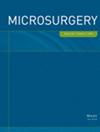Pushing boundaries: Anterolateral thigh free flaps for extensive scalp defects beyond previous limits, leveraging imaging modalities with ultrasound and indocyanine green
Abstract
Background
Scalp defect reconstruction poses considerable challenges, with ongoing debates regarding the most effective strategies. While the latissimus dorsi (LD) flap has traditionally been favored, the anterolateral thigh (ALT) flap has been well described as a versatile alternative for addressing extensive scalp defects. This study underscores the success of scalp reconstruction using ALT flaps, notably pushing the boundaries of previously reported flap sizes. Our approach leverages the use of indocyanine green (ICG) perfusion to guide precise preoperative planning and vascular modification, contributing to improved outcomes in challenging cases.
Methods
We performed 43 ALT flap reconstructions for scalp defects between 2016 and 2023. We collected patients' demographic and clinical data and evaluated flap size and recipient vessels and additional surgical techniques. Detailed preoperative plans with ultrasound and ICG use for intraoperative plans were performed to find perforators location. The cohort was divided into two, with or without complications on flaps, and analyzed depending on its surgical details.
Results
This study involved 38 patients with extensive scalp defects (mean age: 69.4 ± 11 years) who underwent ALT perforator flap transfers (mean flap size: 230.88 ± 145.6 cm2). There was only one case of unsuccessful flap transfer, and four cases had a few complications. The characteristics of the complication group included a large flap size (303.1 ± 170.9 vs. 214.9 ± 136.6 cm2, P = .211), few perforator numbers without pedicle manipulation, lack of intraoperative indocyanine green administration (75% vs. 25%, P = .607), and the use of superficial temporal vessels as recipient vessels.
Conclusions
Scalp reconstruction using large ALT free flaps with the aid of imaging modalities facilitates the optimization of surgical techniques, such as pedicle manipulation, perforator numbers, and vein considerations, thereby contributing to successful reconstruction.

 求助内容:
求助内容: 应助结果提醒方式:
应助结果提醒方式:


